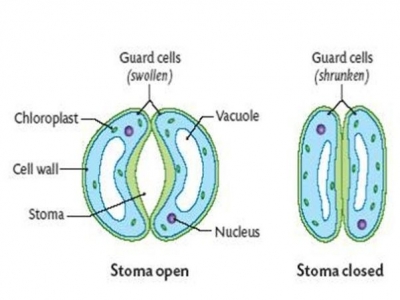
Leaves have very small opening on their surface. Such openings or pores are known as stomata. Stomata generally appear on the underside of the leaves. However, water lilies and other plants that have floating leaves, have stomata on top of their leaves. The purpose of these little pores is to allow gases to go in and out of the leaves. Guard cells control the passage of gases through stomata.
The amount of gases going in and out of a leaf is controlled by guard cells. These openings, or special pores called stomata, are placed on either side of the leaf’s open surface.
Leaves manufacture sugar with the help of chlorophyll in the guard cells during the day time. The sugar attracts water into the cells making them balloon out on the side opposite the pores. When this happens, the pores become open as more carbon dioxide is allowed to move in and more oxygen is released in to the air.
At night, the absence of sunlight prevents photosynthesis. Therefore, no sugar is produced, and the sugar level in the guard cells goes down. No water is allowed into the guard cells, and the pores remain closed. As a result, the movement of gases is limited.
Picture Credit : Google
